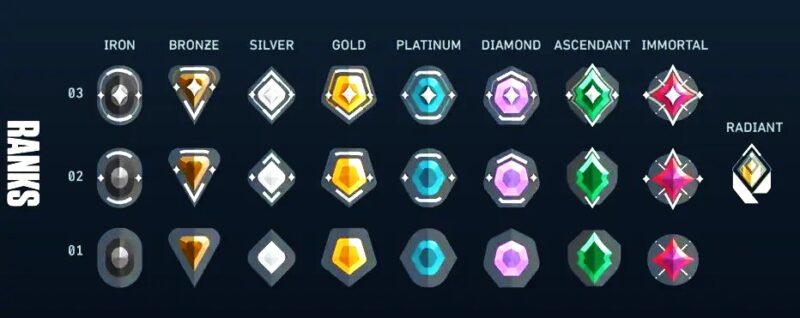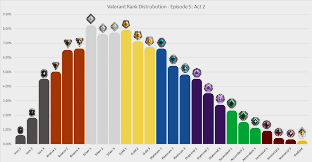Valorant, developed by Riot Games, has become one of the most popular tactical shooters since its release. A significant part of its appeal lies in its competitive mode, which allows players to test their skills and progress through a structured ranking system. The ranking system in Valorant not only reflects your skill level but also pushes you to improve, climb higher, and face more challenging opponents. Understanding how this system works is crucial for anyone looking to compete seriously.
In this guide, we’ll break down everything you need to know about Valorant ranks, from the rank structure to tips on climbing the ladder, and even debunk some common misconceptions. Whether you’re just starting or are a seasoned player, this guide will help you navigate Valorant’s competitive landscape effectively.
Valorant Rank Structure
Valorant’s ranking system is divided into several tiers, each designed to categorize players based on their skill level. There are a total of nine ranks, and each rank (except for Radiant) is further divided into three tiers. Here’s a breakdown:

- Iron: The starting rank, typically for beginners
- Bronze
- Silver
- Gold
- Platinum
- Diamond
- Ascendant: Introduced recently to create a more refined skill distinction
- Immortal
- Radiant: The highest rank, reserved for the top 500 players per region
Each rank is symbolized by a unique icon, making it easy to recognize a player’s rank at a glance. Ranks reflect not only your wins and losses but also your personal performance in each match. Understanding how each rank fits into the overall system is crucial for setting realistic goals and tracking your progress.
Rank Icons & Visual Representation
Every rank in Valorant comes with a distinct icon that visually represents the player’s level. The Iron rank icon, for example, is simple and unadorned, while the Radiant icon is sleek, sharp, and commands respect. These icons are a visual badge of honor in the game, and climbing up to higher ranks is a goal for many players who want to flaunt their skills.
Rank Progression & MMR (Matchmaking Rating)
Now that you understand the ranks, let’s dive into how the progression works. Rank progression in Valorant is based on two main factors: your visible rank and your MMR (Matchmaking Rating).
How Ranking Works
Valorant uses a unique ranking system that goes beyond just wins and losses. While winning matches is crucial, your individual performance within each game also plays a key role. If you consistently perform well, especially in tough matches, you’ll find yourself ranking up faster. On the other hand, if you lose matches or underperform, your rank may drop.
- Winning and losing: A win will increase your rank rating (RR), while a loss will decrease it. However, how much RR you gain or lose depends on your performance and the difficulty of the opponents you face.
- Performance in the match: If you perform significantly better than your current rank, you may earn bonus RR, especially in lower ranks like Iron or Bronze. This allows skilled players to move through the lower ranks more quickly.

MMR vs Rank:
Many players confuse MMR with their actual rank. MMR is an invisible number that represents your true skill level. Even if your rank is visible to you and others, your MMR is a more precise indicator of your abilities.
- MMR is the system that Riot Games uses behind the scenes to match you with players of similar skill. If your MMR is higher than your visible rank, you’ll rank up faster with wins. Conversely, if your MMR is lower, it may take longer to climb even if you’re winning.
Rank Decay: Does It Exist in Valorant?
Unlike some other competitive games, Valorant does not have rank decay based on inactivity. You won’t lose your rank if you take a break from playing. However, if you’re inactive for an extended period, your Rank Rating (RR) might not be accurate compared to your skill level when you return, but you won’t see any penalty for simply not playing.
How to Climb the Ranks: Tips and Strategies
Once you understand how Valorant’s ranking system works, the next step is figuring out how to climb the ladder efficiently. The competition becomes fiercer as you move up, so it’s essential to adopt the right strategies to advance consistently.
Key Factors That Influence Rank Advancement
While winning is essential, other factors play a crucial role in determining how fast you climb the ranks. Here’s what you need to focus on:
- Consistent Performance: Valorant rewards players who consistently perform well across multiple matches. Focus on maintaining a high kill/death ratio (K/D), providing utility for your team (such as using abilities effectively), and avoiding unnecessary deaths.
- Teamwork & Communication: Valorant is a team-based game, and good communication is vital. Players who consistently coordinate with their team, share callouts, and play as part of a cohesive unit are more likely to win matches. Good communication can often be the difference between winning and losing, especially in close games.
- Adapting Your Playstyle: As you rank up, you’ll face smarter and more skilled opponents. Be ready to adapt your playstyle, whether it’s switching to a support role, taking on a more aggressive role, or adjusting your strategy based on the map and opponent’s tactics.
Winning Streaks vs. Loss Streaks
- Winning Streaks: If you’re on a winning streak, your rank will improve more quickly, especially if your MMR is higher than your visible rank. Consecutive wins indicate consistent performance, which the ranking system rewards. Winning streaks often result in a significant increase in your Rank Rating (RR), allowing for faster progression through ranks.
- Loss Streaks: On the other hand, multiple losses in a row can severely affect your rank. However, the system accounts for tough matches, so losing to higher-ranked opponents won’t damage your RR as much as losing to lower-ranked players.
Improving Your Gameplay
To truly climb the ranks, improving your gameplay mechanics and strategies is key. Here are some essential tips to help you step up your game:
- Master One or Two Agents: While it’s good to be versatile, focusing on mastering one or two agents allows you to develop a deep understanding of their abilities and how to use them in various scenarios. This familiarity can be a game-changer in crucial rounds.
- Map Knowledge: Learn the layout of every map. This includes knowing common angles for firefights, the best places to plant and defuse the spike, and where enemies are likely to rotate from. Good map knowledge can give you a significant advantage in decision-making and positioning.
- Watch Pro Gameplay: Watching how professional players approach the game can provide insights into advanced strategies, positioning, and tactics. Try to emulate their discipline and awareness in your own matches.
- Practice in Aim Trainers: Good aim is essential in Valorant. Regular practice using aim trainers can help sharpen your shooting skills, allowing you to react faster and land more headshots.
Rank Distribution: How Competitive Is Each Rank?
If you’re curious about how competitive each rank is, looking at rank distribution can provide some valuable insights. This data gives you an idea of where the majority of players stand and how difficult it is to reach the highest ranks.
Global Rank Distribution Chart
As of the latest data from Riot Games, the rank distribution tends to follow a bell curve, with the majority of players falling into Silver, Gold, and Platinum. Here’s a rough breakdown:
- Iron: ~5% of players
- Bronze: ~15% of players
- Silver: ~35% of players
- Gold: ~25% of players
- Platinum: ~15% of players
- Diamond: ~5% of players
- Ascendant: ~3% of players
- Immortal: ~1% of players
- Radiant: Less than 1% (Top 500 players in each region)
These numbers demonstrate that the bulk of the player base resides in the middle ranks (Silver through Platinum). This makes ranks like Diamond, Immortal, and Radiant incredibly competitive, as only a small percentage of players reach these elite levels.
Common Misconceptions About Valorant’s Ranking System
Myth 1: Winning is Everything
One of the most widespread misconceptions is that only winning matters when it comes to ranking up. While winning is an important factor, your individual performance also plays a significant role, especially in lower ranks. In Iron to Gold, your personal stats (like kills, assists, and damage dealt) can help you rank up even if you lose some matches.
Myth 2: Rank Decay is a Huge Factor
Some players fear that if they take a break from the game, their rank will automatically decay, causing them to lose progress. In Valorant, there is no automatic rank decay based on inactivity. Whether you take a week off or a few months, your rank remains intact.
Myth 3: Ranking Down Means I’m Getting Worse
It’s easy to get discouraged when you see your rank go down after a few losses. However, ranking down doesn’t necessarily mean you’re getting worse.
Recent Changes and Updates to the Ranking System
1. Introduction of Ascendant Rank
One of the most significant updates to the ranking system was the introduction of the Ascendant rank. This rank was added to create more space between Platinum and Immortal, helping distribute players more evenly across the higher skill levels.
2. Changes to Rank Distribution and MMR Adjustment
In recent updates, Riot Games has fine-tuned the matchmaking system to improve the accuracy of rank distribution. MMR adjustment has also been optimized to ensure that players are placed more appropriately in matches against opponents of similar skill levels.
FAQs:
At the start of each new Act, players must complete a series of placement matches to determine their initial rank. These matches take into account your performance from the previous Act as well as your MMR.
The highest rank you can achieve immediately after completing your placement matches is Diamond 1.
Yes, your rank is partially reset at the start of each new Act, requiring you to complete new placements to establish your rank for the season.
Conclusion
Climbing the ranks in Valorant can be both challenging and rewarding. By understanding the ranking system, focusing on consistent performance, and improving your gameplay, you can work your way up to the top. Remember, it’s not just about winning—it’s about mastering the game’s mechanics, playing well with your team, and adapting your strategies as you face tougher opponents. Keep pushing, and with enough practice, you’ll see yourself rise through the ranks and, hopefully, reach Radiant.


